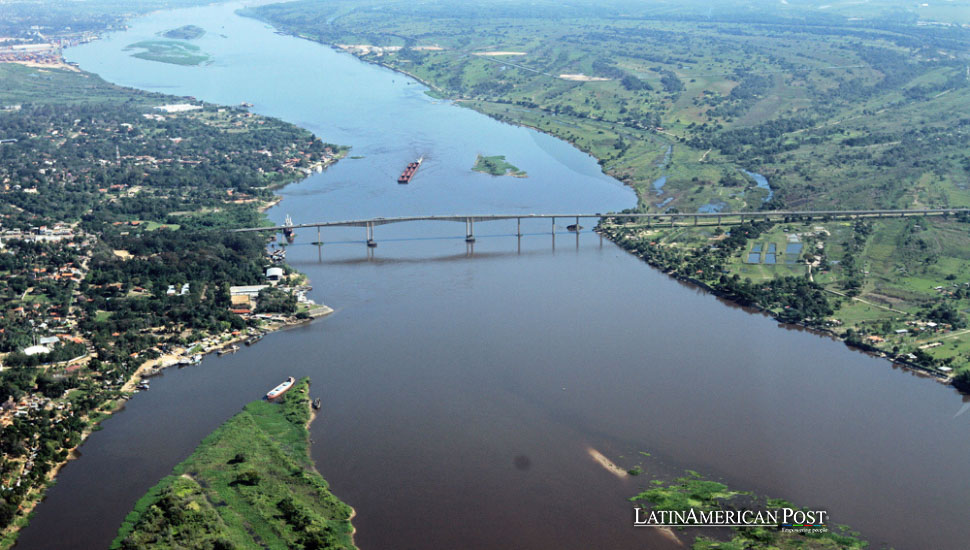Paraguay’s Economic Strain as River Water Levels Plummet

The historic drop in the water levels of the Paraguay River threatens to disrupt Paraguay’s economy, increasing transportation costs and driving up the prices of essential goods. As warnings grow, the nation braces for the potential ripple effects across critical sectors.
Paraguay River Decline
Paraguay’s lifeline, the Paraguay River, is facing an unprecedented drop in water levels, which could have severe consequences for the country’s economy. This river, responsible for mobilizing nearly 80% of Paraguay’s international trade, has hit historic lows, complicating transportation logistics and pushing up the cost of goods. As Rolando de Barros, Paraguay’s Minister of Environment and Sustainable Development (Mades), cautioned in a recent press conference, the situation is bound to worsen, with potential repercussions on everything from fuel prices to the basic food basket.
De Barros did not mince words when discussing the economic implications of the dwindling river. “First, it will affect the economy because prices will start to rise,” he said, pointing out that as the river’s flow decreases, the logistics of moving goods—especially exports—become significantly more difficult and expensive. This crisis could lead to severe disruptions in trade and domestic supply chains for a landlocked country like Paraguay, which depends on the Paraguay-Paraná waterway to access international markets.
The lack of rainfall and persistent drought conditions already impact the river’s capacity. The most alarming sign came when the Paraguay River in the capital, Asunción, recorded a drastic drop to -1.32 meters, far below its normal level. This record low highlights the severity of the crisis and serves as a harbinger of the economic challenges that lie ahead.
Rising Costs in River Trade
The Paraguay-Paraná waterway is a vital artery for the nation’s trade, allowing Paraguay to transport goods to the Atlantic Ocean. However, the declining water levels have made navigating this waterway increasingly difficult. According to the Paraguayan Fluvial and Maritime Shipowners Center (Cafym), ships are now forced to reduce their cargo loads to avoid running aground. This inefficiency has caused a surge in transportation costs, which, in turn, are being passed on to consumers.
For Paraguay, where exports of agricultural products such as soybeans, corn, and beef are crucial to the economy, this means higher costs for shipping goods abroad. Additionally, the import of essential items—fuel, machinery, and consumer goods—has become more expensive. De Barros warned that the price increases will not be confined to specific sectors but will likely affect a broad spectrum of products.
The rise in transportation costs also poses a direct threat to Paraguay’s competitiveness in international markets. As ships carry smaller loads and make more trips, fuel consumption rises, adding to the cost burden. Exporters are finding themselves in a precarious position, as they must decide whether to absorb these increased costs or pass them on to buyers, risking their market position.
As the water levels continue to drop, Cafym has raised concerns that unless swift action is taken, the country could face further disruptions. Ships are already facing delays, and with limited capacity, Paraguay’s ability to fulfill its trade obligations could be jeopardized, potentially leading to shortages of goods in local markets.
Impact on Essential Goods
The consequences of the river’s decline extend far beyond the shipping industry. Paraguay is completely reliant on imports for its fuel supply, and the ongoing crisis is expected to lead to higher prices at the pump. As De Barros pointed out, fuel prices are closely linked to transportation costs. As shipping becomes more expensive, the price of fuel is expected to rise accordingly, placing additional strain on consumers.
Fuel is not the only area of concern. De Barros also warned that the declining river levels could affect the country’s food supply chain. “It may affect the basic food basket, because it’s a chain,” he said, explaining that the rising cost of transportation will likely translate into higher prices for basic goods such as flour, rice, and cooking oil. As shipping costs increase, both raw materials and finished products become more expensive to move, creating a cascading effect on consumer prices.
In a country where many people rely on affordable access to basic goods, these price increases could lead to significant hardship, especially for low-income families. Inflationary pressures, combined with the economic slowdown caused by the COVID-19 pandemic and ongoing drought, have already placed strain on Paraguay’s economy. Now, with the river crisis exacerbating these issues, the situation could become even more dire.
Adding to the problem is the fact that the Paraguay River also plays a critical role in agricultural irrigation. If the drought persists, the country’s agricultural output could suffer, further driving up food prices and threatening Paraguay’s position as a key exporter of grains and meat in the region.
Environmental and Long-Term Implications
While the immediate economic consequences of the river’s decline are significant, the environmental impacts cannot be ignored. The Paraguayan government has acknowledged that the current weather patterns are not encouraging, with forecasts indicating continued dry conditions in the coming months. According to the Director of Hydrology at the National Directorate of Meteorology and Hydrology (DMH), Jorge Sánchez, the rainy season may bring below-average precipitation, prolonging the river’s recovery.
The long-term implications of a prolonged river crisis are concerning. As the river’s flow diminishes, ecosystems that depend on these aquatic environments are at risk. Wetlands, which are crucial for maintaining biodiversity and providing natural flood control, may dry up, leading to a collapse in local ecosystems. This, in turn, could affect fisheries and other industries that rely on the river’s resources.
Moreover, the declining river levels highlight the vulnerability of Paraguay’s infrastructure to climate change. The country’s dependence on the river for transportation and trade leaves it exposed to the growing risks posed by extreme weather events and shifting rainfall patterns. As climate change accelerates, Paraguay—and much of South America—may face more frequent and severe droughts, leading to recurring economic and environmental crises.
Addressing these challenges will require both immediate and long-term strategies. In the short term, the government must explore alternative transportation methods, such as increasing the use of overland routes or expanding the capacity of Paraguay’s railway system. Additionally, investment in water management infrastructure, such as dredging the riverbed to improve navigability, could help mitigate some of the current challenges.
Also read: Paraguay’s Bold Energy Vision: Shifting to Renewables by 2050
In the long term, Paraguay must confront the realities of climate change by investing in sustainable infrastructure and diversifying its economy. Reducing the country’s reliance on the river for trade and transportation will be key to building resilience against future environmental shocks.




